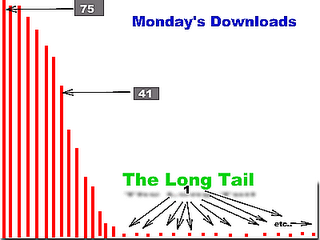
Three of us were sitting in Red Square the other night, when the talk turned to the Long Tail, which is the suddenly fashionable topic amongst the new-media and music industry crowds today.
Before we had a chance to dive too deeply into the topic de jour, one of those “he’s ahead of his time” flashbacks kicked in. My buddy George pointed to the bottle sitting in front of me and said “look at you, talking about Long Tail while you’re drinking a Long Trail.” I guess you had to be there.
Long Tail, for the uninitiated, is a pop economic quasi-model that can best be explained by looking at the accompanying graphic. This represents a day’s activity at our lets-pretend music download business. We have broken a random day’s activity (i.e., file downloads) down by individual artists. The larger bars represent the sales by the most popular and well know performers of the day. 234 downloads were bought from just one single artist. In fact, a handful of artists seemingly dominate the day’s action.
On the opposite end of the chart are the artists whose music was only downloaded once during the same day. The one-timers continue off the chart until they register a final count of 910. This final group -- the 910 -- is what’s referred to as the Long Tail. You see it: the graph’s long tail stretching out? Now you know.
Traditionally, those artists are written off by the giant record labels and their industry co-conspirators as not being worth anything. After all, why would the labels spend hundreds of thousands producing, promoting and marketing a band that was only going to sell one title per day, if that? The retail stores didn’t want any part of them for the same basic reason ---why take up valuable shelf space with inventory that won’t sell?
What’s important here is that so-called ‘Net Economics’ has changed the way these artists are looked at. Once our make believe company’s infrastructure (server, software, bandwidth) is put into place, it costs next to nothing to add additional inventory (i.e., artists and their music files)---maybe a penny or two. All of sudden, the 99 cents x 1 = 99 cents revenue stream for Joe Blow and the Blowhards looks like it is contributing a pretty healthy margin to our sales -- and with no ongoing carrying costs. Why not add them and give them a chance in the open market?
The real world echoes our fantasy chart: sales figs from the download services reflect the same pattern. Even though the top selling fifty artists may each individually have huge numbers that dwarf those of the individual Long Tail’ers, it is the latter group’s aggregate power that matters. If you add up all of the one-sale artists, their total figure will outnumber the Top Fifty’s aggregate figure.
That is the dynamic that makes today’s media world so interesting. The net has provided a framework for the little guy or gal -- the indy artist – to distribute music in the same arena as the industry backed megastars. As a result, artists no longer even look at the “big record deal” as being the ultimate necessity for achieving success in the music business. They’ve heard enough horror stories from their comrades about getting ripped off by Hollywood accounting. So, instead of letting a label force them to go blow $300K on a recording session, followed by getting billed for another $300K for promotion – why not just go into a local studio and get it done for $5K and sell it on their own at live shows and through the myriad of websites that will now gladly take them on?
Big Media, of course, still doesn’t get it. The whole concept is totally foreign to their age old model of recycling old talent with a few hand picked newcomers tossed into the mix --- because it’s cheaper to market. Local tastes and niche genres are a thing of the past as the multi-market conglomerates spew the same garbage across their vast empires, turning the cultural landscape into a United States of Mediocrity.
Back at our table, we were rejoicing the news of a regional rock and roll band turning down a label deal with one of the big players. Under the new economic model, they have an equal chance of succeeding as an indy as they do in a big stable.
The other Long Tail topic that made our Square Table discussion was NBC’s recent ‘embrace’ of YouTube. Apparently, they were pissed about some clip from one of their shows being shown on this increasingly popular video sharing website. But in a gag-me P/R stunt, they ran a segment on their own Nightly News talking about “now we get it” and “we’re late to the party, but we really are hip to it all, kids.”
The result? They’re now happily producing trailers from all of their youth-centric TV shows and uploading them to YouTube. The goal? You guessed it folks – drive them back to the broadcast channel and let them slurp up their normal run of Lowest Common Denominator entertainment. Plus those catchy advertising spots, of course.
They might accomplish just that with a few folks. But what they don’t know is what is eventually going to kill them. For while they gleefully slap each other on the back because the figs tell them 4,000 people watched their big new show’s catchy trailer, there were 4,000,000 others out there who at the same time were watching backyard wrestling tournaments, barfing contests, karaoke sessions and skateboard punks.
Yes, the Long Tail is silently working its magic.
1 comment:
Sometimes I like to start at the roots to see how things grow. Who would have thought the King of the head-heel takedown would be so good at doing it with words! - Good job, John G.
Post a Comment